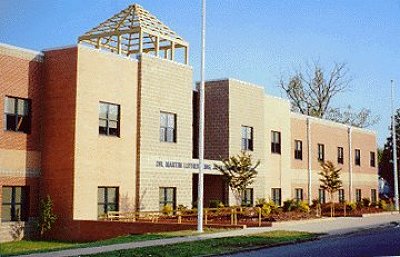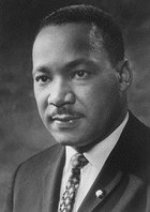M.L. King

Martin Luther King, Jr., Elementary was constructed in 1993. This is the third LRSD school to bear the name of the great civil rights leader. The first was Granite Mountain Elementary at 201 Gillam Street (its name was changed to Martin Luther King, Jr., Intermediate School in 1981); this school closed in 1982. The second was Oakhurst Elementary at 4800 West 26th Street (it changed its name to Martin Luther King, Jr., School in 1982). This school ceased operation as a school in 1990 and now serves as the LRSD Adult Education Center.
The new building and the Dr. Martin Luther King Jr. Commission were dedicated in a joint ceremony on December 5, 1993. Rev. Derek B. King, a nephew of Dr. King, was present to help dedicate the school and the commission. Martin Luther King, Jr., Elementary offers a high-intensity learning magnet program, concentrating on student-centered learning experiences rather than a teacher-centered approach. It is an interdistrict school, serving students from all three school districts in Pulaski County.

Martin Luther King, Jr., (1929-1968) was born Michael Luther King, Jr., but later changed his first name to Martin. His grandfather and his father served as pastors of the Ebenezer Baptist Church in Atlanta, and from 1960 until his death King acted as co-pastor at this now-historic church. King attended segregated public schools in Georgia, graduating from high school at the age of fifteen. He received a B.A. degree from Morehouse College in Atlanta, a B.D. from Crozer Theological Seminary in Pennsylvania and a doctorate from Boston University. While in Boston, he met and married Coretta Scott. In 1954 Dr. King became pastor of the Dexter Avenue Baptist Church in Montgomery, Alabama. Always a strong worker for civil rights, Dr. King was a member of the executive committee of the NAACP.
Early in December 1955 he led the first great Negro nonviolent demonstration of contemporary times: the Montgomery bus boycott. After a year of boycotts, the U.S. Supreme Court declared unconstitutional the laws requiring segregation on buses, and African-Americans and whites rode the buses as equals. In 1957 Dr. King was elected president of the Southern Christian Leadership Conference, and between 1957 and 1968 he traveled over six million miles and spoke over 2,500 times. In these years he led a massive protest in Birmingham, inspiring his "Letter from a Birmingham Jail;" he planned the drives in Alabama for African-American voter registration; he directed the peaceful march on Washington, D.C., of 250,000 people to whom he delivered his famous "I Have a Dream" speech; he conferred with President John F. Kennedy and campaigned for President Lyndon B. Johnson; he was arrested more than 20 times and assaulted at least four times; he was awarded five honorary degrees; he was named "Man of the Year" by Time Magazine; and he became the symbolic leader not only of African Americans but also of people of all races all around the world.
At the age of 35 Dr. Martin Luther King, Jr., became the youngest man to receive the Nobel Peace Prize. He was assassinated on the evening of April 4, 1968, while standing on the balcony of his motel room in Memphis, Tennessee, where he was to lead a protest march in sympathy with the striking garbage workers of that city.
Sources:
LRSD archives.
"MLK's nephew dedicates LR school," Arkansas Democrat-Gazette article by Ward Pincus, 6 Dec 1993; page 1B.
"LR schools named for prominent people," Arkansas Democrat article by Cynthia Howell, 18 Apr 1983; page 10B.
The Nobel Prize web site; Martin Luther King, Jr., biography page. If you have information about a Little Rock school or photographs that you would like to contribute to this project (we will return photographs if requested), please contact us!
Updated March 2005
